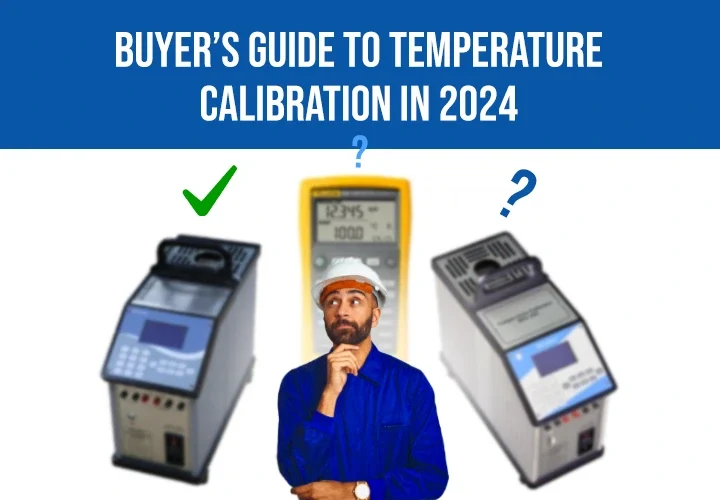Temperature is the most routinely monitored characteristic across all industries. Temperature calibration equipment is required to guarantee accuracy. Temperature measurement necessitates the use of a variety of specialist sensors, including thermistors, thermocouples, infrared sensors (IR), bimetal thermometers, and resistive temperature detectors (RTSs), which can help you choose which will best meet your needs. This guide will help you discover the right temperature calibrator for your needs!
What is a Temperature Calibrator?
Temperature calibrators come in various designs and are commonly referred to as calibrators, although they may also be referred to as temperature indicators or simulators. A calibrator must ensure that a temperature sensor accurately measures the actual temperature in the environment in which it is used. It must also have a steady temperature source capable of attaining the specified temperature range.
Know About The Different Types Of Temperature Calibration Tools
When choosing a temperature calibrator, three characteristics are critical. Knowing these 3 things can assist you in choosing the best temperature calibrator.
- Accuracy: The difference in temperature between the instrument’s display and the actual temperature of the calibration well. The point at which the measured reading resonates with the original value.
- Stability: When a calibrator reaches its set point, there is some temperature variation as the machine strives to maintain that temperature. The calibrations may be affected by the instability. Stability improves accuracy in calculating total system uncertainty.
- Uniformity: Temperature uniformity of the heat source across the test zone. All calibrators differ at the top, middle, and bottom. The user must position the probes to reduce uniformity mistakes to achieve uniformity.
So, what are the types of temperature calibrators?
1. Dry Blocks
Dry blocks are adaptable temperature calibrators that can heat and cool a metal block to a precise temperature and keep it there. It provides a consistent temperature source and may be modified to test various places. Furthermore, they are lightweight and may be readily taken to the field. These devices create a stable and controlled environment for temperature calibration. With interchangeable inserts to accommodate different sensors, dry block calibrators offer flexibility for various calibration needs.
2. Temperature Baths
A temperature calibration bath is a standardised container containing a stirred fluid that may be changed to various temperature test points. They provide great thermal contact, homogeneity, and stability for the temperature sensor calibrator. Furthermore, because they do not rely on drilled inserts, they may calibrate many inserts at the same time.
Also Read: Temperature Bath vs Dry Block Calibrators
3. Thermocouple / RTD Calibrators
Thermocouple / RTD Calibrators use electrical circuitry to assess the accuracy of temperature sensors. They can provide technicians with an easy, low-cost option to test in the field.
4. Infrared Calibrators
Infrared calibrators are extremely useful for non-contact temperature readings in industries where direct touch is difficult. They deliver quick and precise readings, improving calibration process efficiency.
What Else to Consider?
Assessing your specific requirements is crucial before diving into temperature calibration tools. Consider the range of temperatures your processes involve, the level of accuracy needed, and the types of instruments you’ll be calibrating. What else?
- Traceability and Compliance: Traceability is the lifeline of calibration. Ensure the calibration tools adhere to international standards and are traceable to calibration laboratories.
- Environmental Considerations: Temperature calibration often occurs in diverse environmental conditions. Select tools that can withstand and operate effectively in the environments of your processes. Robustness and durability are crucial factors, especially in industries with challenging conditions.
Emerging Technologies:
- Advanced Sensors: Integrating advanced sensors enhances the precision and speed of temperature calibration. Look for instruments that incorporate cutting-edge sensor technologies for superior accuracy.
- Machine Learning and AI: Some calibration tools now leverage machine learning algorithms and artificial intelligence to analyse calibration data and optimise the calibration process over time. These smart features contribute to increased efficiency and continuous improvement.
Find your Ideal Calibrator with Nagman!
As you select temperature calibration tools in 2024, remember that precision is necessary and a strategic advantage. In this era of technological leaps, where every degree matters, your choice of temperature calibration tools plays a pivotal role in ensuring the integrity of your processes.
So, whether you opt for advanced sensors, leverage AI capabilities, or stick to tried-and-true methods, Nagman has the right calibrator for your needs! So, why not check us out? Be future-ready with the best temperature calibrators with Nagman!



